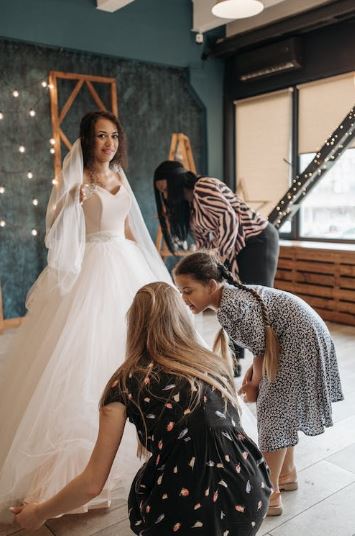The clothing worn by the bride in a wedding ceremony is called a wedding gown or a wedding dress. White is the most popular color of a wedding gown especially in the Western culture. It was made popular by Queen Victoria in the 19th century. In the Eastern culture, brides choose red wedding gowns as a symbol of auspiciousness but virgins on the other hand, wear white wedding gowns.
Western Culture
Today, weddings are a symbol of love and commitment between two people. But back in the Middle Ages, weddings are like the union of two families, two businesses, or two countries. They join together for a beneficial arrangement. And back in those times, the wedding dress is something that represents not just the bride, but the bride’s family as well in the best light, usually in terms of wealth and social standing.
Brides from well-off families usually wore wedding gowns with rich colors and high-class fabrics. It was also common to see them wear bold colors and layers of furs, velvet, and silk. Poor brides on the other hand wore their best church dresses on their wedding day.
The first princess who wore a white wedding gown in a royal wedding ceremony was Philippa of England. She wore a tunic with a cloak in white silk which is bordered with grey squirrel and ermine in 1406. In 1559, when Mary, Queen of Scotts married her first husband, she also wore a white wedding gown because it was her favorite color even though white is a symbol of mourning for French Queens. Wearing a white wedding gown was not a widespread tradition. In fact, in the Victorian era, brides wore different colors of wedding gowns when they get married. Black is the most popular color of wedding gowns in Scandinavia.
It was in the 1840 when white became popular in wedding gowns after the marriage of Queen Victoria to Albert of Saxe-Coburg. She wore are white gown trimmed with Honiton lace. Lots of illustrations of the wedding were published and since then, many brides chose white wedding gowns in accordance with the Queen’s choice.
In the early 1900s, decorations such as lace or frills were adopted in wedding dresses. In the 1920s, wedding gowns were typically short in front with a longer train in the back and worn with cloche-style wedding veils. This fashion continued until the late 1960s.
In the present time, Western wedding gowns are white, though it includes the shades of eggshell, ecru, and ivory. Many people began to think of the color white as a symbol of virginity but this wasn’t really the intention because blue was the color connected to purity and faithfulness.
Many of the wedding gowns today are sleeveless, because these kinds of dresses are easier to alter to be able to fit perfectly. But sleeved and strapped wedding gowns became popular as the years passed.
Eastern Culture
In Asian countries like China, Pakistan, India, and Vietnam, wedding gowns are red, which is a traditional color that symbolizes good luck and auspiciousness. But today, many women choose other colors of wedding gowns aside from red. In modern Chinese weddings, brides can now choose Western wedding gowns of any color. They would just put on their traditional costume on the official tea ceremony.
In modern Taiwanese weddings, brides usually pick red or white wedding gowns. However, most of them still choose the traditional red wedding gowns for their formal wedding dinners.
In the Indian culture, red wedding saris, which are silk in material, are the traditional clothing worn by brides. But as the years pass, the color options and fabric choices for Indian brides have expanded.
In Japanese weddings, a traditional pure white kimono is often worn by the brides as a symbol of purity and maidenhood. After the wedding ceremony, brides change into a red kimono for good luck.
In Indonesia, the Javanese brides wear a kebaya. It is their traditional blouse and is paired with batik. In the Philippines, the traditional wedding gowns are called baro’t saya. Various tribes and Muslim Filipinos on the other hand wear other forms of traditional dresses during their wedding ceremonies.
Native American Culture
The indigenous people in America also have traditions when it comes to wedding dresses. The wedding dress of Hopi brides were usually woven by the grooms and other men in their village who wants to participate. Their wedding gowns have large belts, two all-white wedding robes, and red and white wedding robes at the top and bottom. Their wedding gowns also served as shrouds, because these will be used in their trip through the underworld. A Pueblo bride on the other hand, wore a cotton wedding dress which is tied above the right shoulder secured with a belt on the waist.
It’s amazing to know that brides in different cultures have their own way of choosing and designing their wedding gowns, and more than making them look more beautiful in their special day, wedding gowns also hold a lot of meaning. But these days, brides can now choose from lots of different wedding gown colors, styles, and fabrics. Though white is still the most popular color of wedding gowns today, it no longer symbolizes wealth, but purity and virtue instead.

